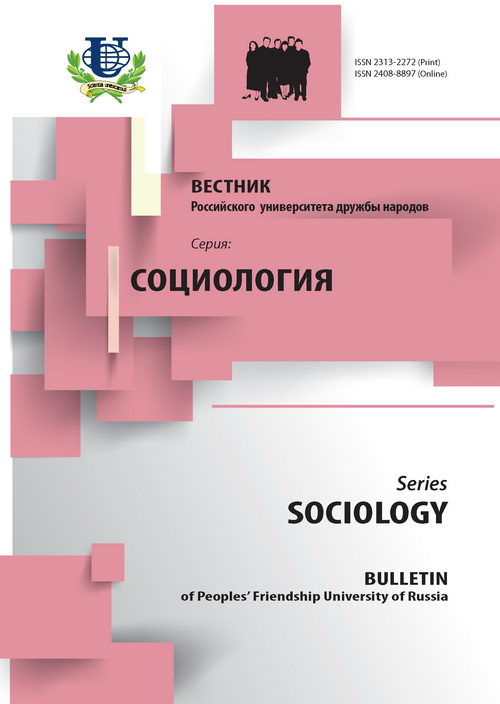Гражданская и этническая идентичность как маркеры межэтнических отношений в приграничных регионах России
- Авторы: Максимова С.Г.1, Морковкина А.Г.2
-
Учреждения:
- Алтайский государственный университет
- Московский государственный университет им. М.В. Ломоносова
- Выпуск: Том 16, № 2 (2016)
- Страницы: 347-358
- Раздел: Массовые опросы, эксперименты, кейс-стади
- URL: https://journals.rudn.ru/sociology/article/view/6475
Цитировать
Полный текст
Аннотация
В статье представлены результаты исследования гражданской и этнической идентичности и состояния сферы межэтнических отношений в восьми субъектах Российской Федерации, расположенных вблизи государственных границ: Алтайского края, Амурской области, Еврейской Автономной области, Забайкальского края, Кемеровской области, Омской области, Оренбургской области, Республики Алтай. Сбор первичных данных был осуществлен методом анкетного опроса. На основе анализа полученных данных констатируется приоритет гражданской идентичности для жителей приграничных регионов Российской Федерации. Определены преобладающие основания гражданской и этнической идентичности. Между исследованными регионами выявлены существенные различия в уровне проявления различных типов идентичности: наибольшая степень отождествления с гражданским и этническим сообществами отмечается в Кемеровской области, наименьшая - в Забайкальском крае. Также дана оценка характеристик межэтнических отношений, сделаны выводы об их динамике и уровне межэтнической напряженности в каждом из регионов. Наиболее проблемными в этом отношении регионами среди вошедших в исследование можно считать Забайкальский край и Омскую область. В ходе исследования выявлен ряд эмпирических фактов, требующих дальнейшей научной интерпретации: например, наличие в отдельных регионах статистически значимых долей населения с крайне низким уровнем национально-государственной идентификации как таковой.
Об авторах
Светлана Геннадьевна Максимова
Алтайский государственный университет
Автор, ответственный за переписку.
Email: svet-maximova@yandex.ru
Кафедра психологии коммуникаций и психотехнологий
Анастасия Геннадьевна Морковкина
Московский государственный университет им. М.В. Ломоносова
Email: soccomsys@mail.ru
Кафедра социологии коммуникативных систем
Список литературы
- Горшков М.К. Российская идентичность в условиях трансформирующихся процессов // Вестник российской нации. 2008. № 1.
- Гроздья гнева. Рейтинг межэтнической напряженности в регионах России // ЦИНК, 2014. URL: http://club-rf.ru/thegrapesofwrath/01/index.html.
- Дробижева Л.М. Теоретические проблемы изучения гражданской идентичности и социальная практика // Сетевое издание Центра исследований и аналитики Фонда исторической перспективы «ПЕРСПЕКТИВЫ», 2014. URL: http://www.perspektivy.info/rus/gos/ teoreticheskije_problemy_izuchenija_grazhdanskoj_identichnosti_i_socialnaja_praktika_2014-09-10.htm.
- Зимина Н.С., Колпакова Т.В. Внутренний имидж Байкальского региона в контексте его социокультурного развития (на примере Забайкальского края) // Современные проблемы науки и образования. 2014. № 6.
- Шикова Р.Ю. Гражданская идентичность современной молодежи: социокультурный анализ (на примере республики Адыгея): Автореф. дисс.. к.с.н. Майкоп, 2010.
- Широкогоров С.М. Этнос. Исследование основных принципов изменения этнических и этнографических явлений. М., 2010.
- Berry J.W. Acculturation and psychological adaptation review // Journeys into Cross-Cultural Psychology: Selected papers from the 11th International conference of the International association for cross-cultural psychology held in Liege, Belgium. Ed. by A.M. Bouvy. Liege, 2006.
- Iyer A., Jetten J., Tsivrikos D., Postmes T., Haslam S.A. The more (and the more compatible) the merrier: Multiple group memberships and identity compatibility as predictors of adjustment after life transitions // British Journal of Social Psychology. 2009. № 48.
- Nasie M., Bar-Tal D., Pliskin R., Nahhas E., Halperin E. Overcoming the barrier of narrative adherence in conflicts through awareness of the psychological bias of naive realism // Personality and Social Psychology Bulletin. 2014. № 40.
- Smith T.W. National pride in comparative perspective // The International Social Survey Programme 1984-2009: Charting the Globe. London: Routledge, 2009.
- Swann W.B.Jr., Gamez A., Seyle C.D., Morales F.J., Huici C. Identity fusion: The interplay of personal and social identities in extreme group behavior // Journal of Personality and Social Psychology. 2009. № 96.
- Tajfel H., Turner J.С. The social identity theory of intergroup behavior // Psychology of Intergroup Relations. Ed. by S. Worchel, W.G. Austin. Chicago: Nelson-Hall, 1986.














